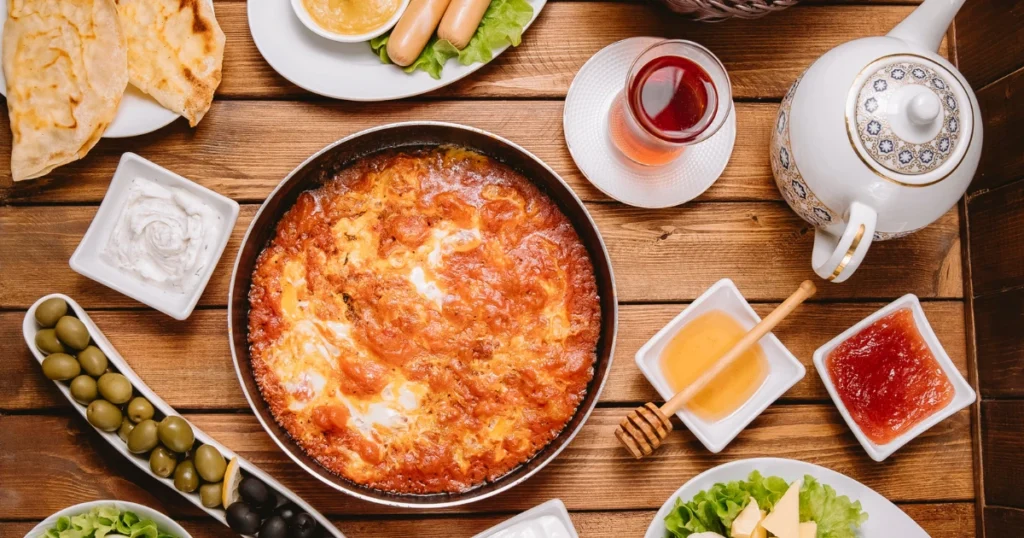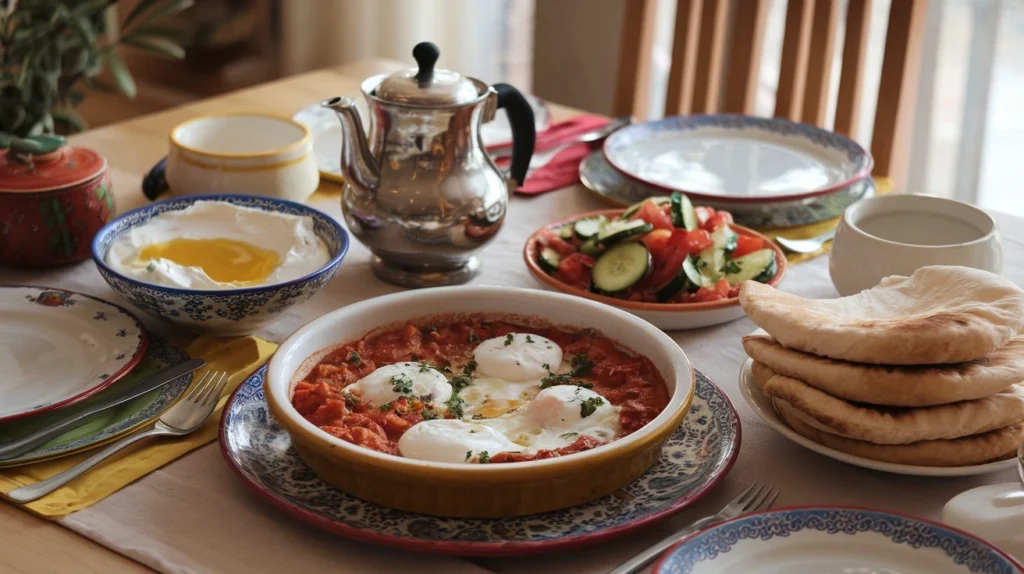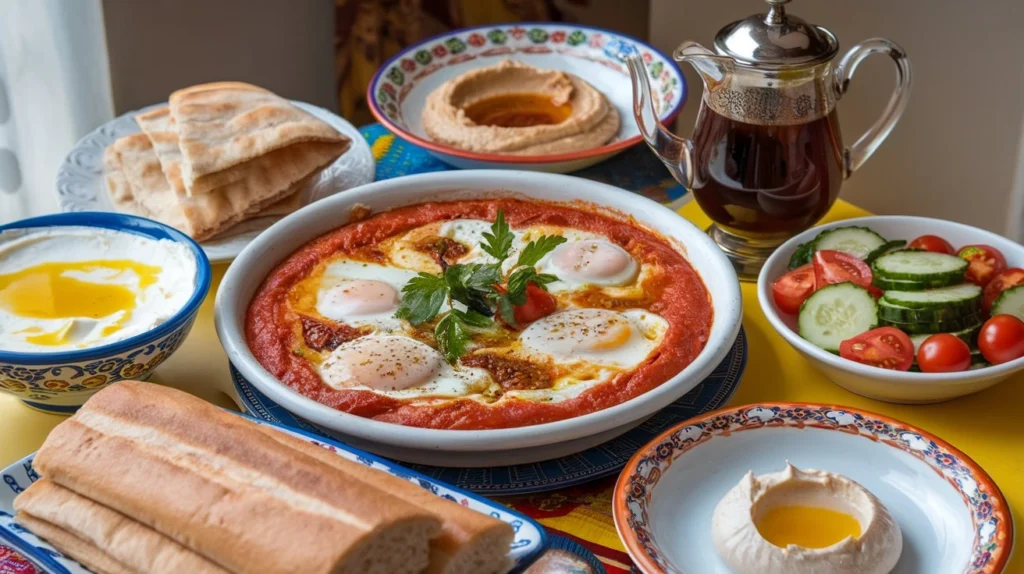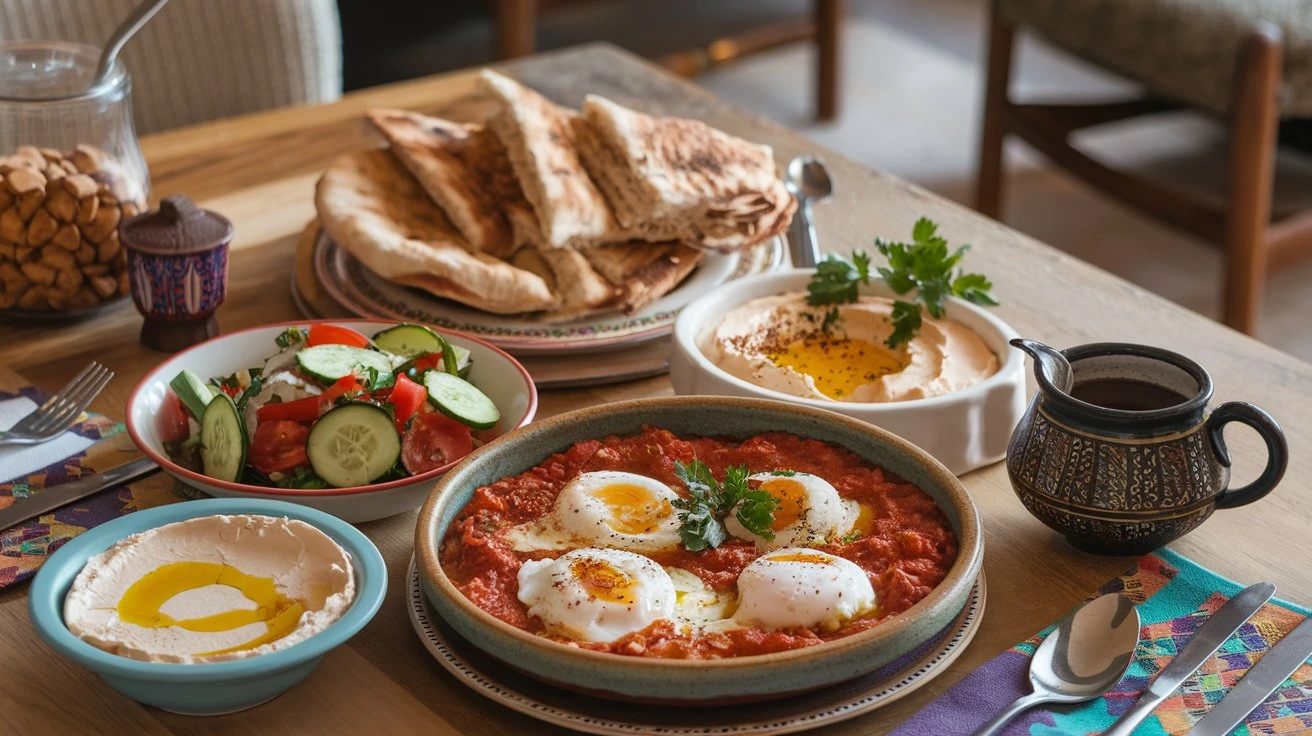What do you picture when you think about breakfast? For many, it’s a quick meal to start the day, but in the Middle East, breakfast is an experience that encapsulates warmth, tradition, and vibrant flavors. As you step into this culinary world, you’ll discover that a traditional Middle Eastern breakfast is not just about the food; it’s about connection, hospitality, and the joy of sharing.
Picture yourself waking up to the enticing aroma of spices blending with the scent of freshly baked bread. The colors of ripe tomatoes, crisp cucumbers, and creamy labneh create a feast for the eyes even before the first bite. This meal is often enjoyed leisurely, inviting family and friends to gather around the table, savoring each dish and relishing in conversation.
The beauty of a Middle Eastern breakfast lies in its variety. You might find a warm plate of shakshuka, with its poached eggs nestled in a rich, spiced tomato sauce, or a platter of fresh vegetables paired with fluffy pita bread. Each element tells a story, rooted in rich culinary traditions passed down through generations.
As you embark on this journey to recreate a traditional Middle Eastern breakfast at home, you’ll not only learn to prepare delightful dishes but also immerse yourself in the culture that cherishes this important meal. Get ready to transform your mornings into a celebration of flavors, textures, and heartwarming connections.
Table of Contents
What Defines a Traditional Middle Eastern Breakfast?
When you think about what makes a breakfast truly traditional in the Middle East, it’s essential to consider the rich tapestry of flavors, ingredients, and cultural practices that come together. A traditional Middle Eastern breakfast is much more than a simple meal; it is a celebration of community, heritage, and the joy of sharing food with loved ones.
At the heart of this breakfast are staple ingredients that reflect the region’s agriculture and culinary history. You’ll find fresh vegetables like tomatoes, cucumbers, and radishes, which not only add color but also provide a refreshing crunch. These ingredients are often served alongside creamy labneh, a strained yogurt that brings a tangy richness to the table and pairs beautifully with warm, fluffy pita bread.
Spices play a crucial role in defining this breakfast. You might encounter za’atar, a fragrant blend of herbs that elevates the simplest dishes. This mixture often finds its way onto labneh or is sprinkled over eggs, adding depth and complexity to each bite.
In many Middle Eastern cultures, breakfast is a communal affair. It’s not just about the food; it’s about gathering around the table, enjoying the moment, and engaging in conversation. This meal often includes various dishes, allowing everyone to share and taste different flavors. You might serve shakshuka alongside a fresh salad, creating a colorful and diverse spread that invites exploration.
Moreover, each region has its unique twist on breakfast, influenced by local customs and ingredients. From the spicy egg dishes of North Africa to the lighter fare found in the Levant, the variations are endless. This diversity underscores the importance of breakfast as a reflection of cultural identity and local traditions.
As you delve deeper into what constitutes a traditional Middle Eastern breakfast, you’ll discover that each element is thoughtfully chosen. It’s a blend of flavors, textures, and experiences that not only nourish the body but also feed the soul. Embracing this breakfast tradition allows you to connect with a rich culinary heritage that has stood the test of time.
Essential Ingredients for a Middle Eastern Breakfast

To truly capture the essence of a Middle Eastern breakfast, you’ll want to familiarize yourself with the key ingredients that make this meal so special. Each component not only adds flavor but also contributes to the overall experience, transforming your breakfast into something memorable.
Labneh
One of the standout ingredients is labneh, a creamy, tangy yogurt that serves as a versatile spread or dip. As you prepare your breakfast, consider making your own by straining plain yogurt overnight. The result is a thick, luscious texture that pairs beautifully with fresh vegetables and pita. Enjoy it drizzled with olive oil and sprinkled with za’atar for an authentic touch.
Pita Bread
Next, you can’t overlook pita bread. This soft, round flatbread is a staple in Middle Eastern cuisine. It’s perfect for scooping up dips, wrapping around fillings, or simply enjoying alongside your breakfast spread. Warm it up in a skillet or oven to enhance its flavor and texture, making it an inviting addition to your table.
Fresh Vegetables
Incorporating a variety of fresh vegetables is essential. You’ll want to include crisp cucumbers, juicy tomatoes, and perhaps some radishes for an added crunch. These vegetables not only provide color but also freshness, balancing the richness of dishes like labneh and shakshuka. You can enjoy them raw, sliced, and arranged beautifully on your plate.
Eggs
Eggs are often the centerpiece of a Middle Eastern breakfast, particularly in the form of shakshuka. This dish features poached eggs nestled in a vibrant sauce made from tomatoes, bell peppers, and spices. You can experiment with the level of spice to suit your taste, making it as mild or as fiery as you prefer.
Za’atar
Don’t forget about za’atar, a fragrant herb blend that elevates many dishes. Typically made from thyme, sesame seeds, and sumac, this seasoning adds a unique depth to your breakfast. Sprinkle it over labneh or mix it into scrambled eggs for an extra layer of flavor.
Olive Oil
Finally, high-quality olive oil is a must-have. Use it generously to drizzle over your labneh, salad, or shakshuka. Its rich, fruity flavor ties all the elements together, enhancing both taste and texture.
By gathering these essential ingredients, you’ll be well on your way to creating a delicious and authentic Middle Eastern breakfast. Each item plays a vital role, contributing to a meal that is not only satisfying but also a true reflection of the region’s culinary heritage. Embrace these flavors, and you’ll find yourself not just cooking but connecting with a rich tradition that celebrates food and togetherness.
Step-by-Step Guide to Preparing a Middle Eastern Breakfast
Preparing a traditional Middle Eastern breakfast is a rewarding experience that invites you to savor each step. By following this guide, you’ll create a flavorful and inviting meal that showcases the best of this culinary tradition. Let’s dive into the process, ensuring you have everything you need to bring these delicious dishes to your table.
1. Preparing the Base: Pita and Labneh
Start with labneh, as it requires some preparation. If you’re making your own, take plain yogurt and mix it with a pinch of salt. Place the mixture in a cheesecloth or a fine strainer over a bowl, allowing it to drain in the refrigerator overnight. This step will yield a thick, creamy labneh that’s perfect for spreading.
While the labneh is draining, you can warm your pita bread. Heat a skillet over medium heat and place the pita in the pan for about 1-2 minutes on each side until it’s warm and slightly puffed. Alternatively, you can wrap the pita in aluminum foil and warm it in the oven.
2. The Star of the Meal: Shakshuka
Now, let’s focus on shakshuka, the heart of your breakfast. Begin by chopping one onion and one bell pepper. Warm a tablespoon of olive oil in a big skillet on medium heat. Sauté the onion until it becomes translucent, then add the bell pepper and continue to cook until softened.
Next, add two cups of diced tomatoes (canned or fresh) to the skillet, along with your spices—typically cumin, paprika, and a pinch of chili powder for heat. Stir everything together, allowing the mixture to simmer for about 10 minutes until it thickens slightly.
Once your sauce is ready, make small wells in the mixture and crack in your eggs, taking care not to break the yolks. Cover the skillet and let it cook for about 5-7 minutes, or until the eggs are set to your liking. If you prefer a firmer yolk, you can cook it a bit longer.
3. Fresh Vegetable Salad
While the shakshuka is cooking, prepare a fresh vegetable salad to accompany your meal. Dice cucumbers, tomatoes, and radishes, and toss them together in a bowl. Sprinkle some chopped parsley on top for a fresh touch. Drizzle with olive oil and a squeeze of lemon juice, seasoning with salt to taste. This salad will provide a refreshing contrast to the warm shakshuka.
4. Traditional Spiced Tea or Coffee
To round out your breakfast, brew a pot of traditional spiced tea or coffee. For tea, steep black tea with fresh mint leaves and a touch of sugar. If you prefer coffee, try brewing Arabic coffee, which is richly flavored and often spiced with cardamom. Serve it hot alongside your breakfast for a complete experience.
5. Plating Your Breakfast
Now that everything is prepared, it’s time to plate your breakfast. Arrange the warm pita on a platter alongside the labneh, garnished with a drizzle of olive oil and a sprinkle of za’atar. Serve the shakshuka directly from the skillet, allowing everyone to dig in. Present the fresh vegetable salad in a separate bowl, inviting your guests to help themselves.
Enjoying the Meal
As you gather around the table, take a moment to appreciate the vibrant colors and enticing aromas. This breakfast is not only a feast for the senses but also an opportunity to connect with family and friends. Enjoy the flavors, share stories, and make this meal a cherished part of your morning routine.
By following these steps, you’ll create a Middle Eastern breakfast that is both delicious and deeply satisfying, allowing you to experience the rich culinary heritage of this vibrant region.
Complementary Dishes to Enhance Your Breakfast


As you prepare your traditional Middle Eastern breakfast, consider the delightful complementary dishes that can elevate your meal to new heights. These additions not only enhance the flavors but also create a more diverse and satisfying experience. Let’s explore some popular options that pair beautifully with your main dishes.
Fresh Vegetable Salad
A fresh vegetable salad is an essential component of a Middle Eastern breakfast. Its bright, crisp flavors provide a refreshing contrast to the richness of dishes like shakshuka and labneh. To make this salad, simply chop a variety of seasonal vegetables such as cucumbers, tomatoes, and bell peppers. You can also add radishes for an extra crunch.
For added flavor, toss in fresh herbs like parsley or mint. Drizzle the salad with a mixture of olive oil and lemon juice, seasoning it with salt and pepper to taste. This vibrant salad not only adds color to your table but also brings a healthy balance to your meal.
Ful Medames
Another classic dish you might consider is ful medames, a hearty fava bean dish often enjoyed for breakfast. To prepare ful medames, cook fava beans until tender, then mash them slightly and mix with garlic, lemon juice, olive oil, and spices. Top with a sprinkle of cumin and chopped parsley before serving. This dish is rich in protein and fiber, making it a nourishing addition to your breakfast spread.
Spiced Potatoes
Spiced potatoes are another wonderful accompaniment that adds warmth and comfort to your meal. You can cube potatoes and sauté them with onions, garlic, and a blend of spices such as cumin and paprika. Cook until the potatoes are golden and crispy on the outside, soft on the inside. This dish complements the other flavors and adds a satisfying texture to your breakfast plate.
Hummus
No Middle Eastern breakfast would be complete without hummus. This creamy chickpea dip is not only delicious but also incredibly versatile. You can serve it plain or enhance it with flavors like roasted garlic, smoked paprika, or tahini. Spread it on your warm pita or enjoy it with fresh vegetables for a delightful pairing. The smoothness of hummus balances the heartiness of shakshuka and the crunch of your salad.
Traditional Spiced Tea or Coffee
To round out your breakfast, consider serving a traditional spiced tea or coffee. A pot of mint tea can offer a refreshing counterpoint, while Arabic coffee, rich and aromatic with hints of cardamom, adds warmth and depth. Both beverages are perfect for sipping as you enjoy your meal and can help create a cozy, inviting atmosphere.
Plating and Presentation
As you arrange these complementary dishes on your table, think about presentation. Use colorful platters and bowls to display the vibrant ingredients. This not only enhances the visual appeal but also encourages everyone to explore the various flavors available.
By incorporating these complementary dishes into your Middle Eastern breakfast, you create a well-rounded meal that delights the senses and fosters a sense of community. Each dish contributes its unique taste and texture, making your breakfast not just a meal but a celebration of culture and connection. Enjoy the process of sharing these delicious creations with your loved ones, turning an ordinary morning into a special occasion.
(FAQ)
As you explore the delightful world of Middle Eastern breakfast, you may have some questions about the dishes, ingredients, and traditions associated with this meal. Below are some frequently asked questions that can help enhance your understanding and enjoyment of this culinary experience.
What is a traditional Middle Eastern breakfast?
A traditional Middle Eastern breakfast is a vibrant and varied meal that often includes dishes such as shakshuka, labneh, fresh vegetables, and pita bread. It emphasizes communal dining, where family and friends gather to share a range of flavors and textures. The meal is typically rich in fresh ingredients, herbs, and spices, reflecting the diverse culinary heritage of the region.
Can I make a vegetarian Middle Eastern breakfast?
Absolutely! Many traditional Middle Eastern breakfast dishes are naturally vegetarian. You can enjoy shakshuka, labneh, hummus, and a variety of vegetable salads without any meat. Additionally, dishes like ful medames, spiced potatoes, and fresh herbs can add depth and satisfaction to your vegetarian spread.
How can I serve breakfast for a crowd?
Serving a Middle Eastern breakfast for a larger group can be a delightful experience. Consider preparing dishes that can be made in advance, such as shakshuka or ful medames. Set up a buffet-style arrangement where guests can help themselves to various dishes like labneh, hummus, and salads. This encourages sharing and allows everyone to sample a bit of everything at their own pace.
What beverages pair well with Middle Eastern breakfast?
Traditional beverages that complement a Middle Eastern breakfast include spiced tea and Arabic coffee. Mint tea is refreshing and light, while Arabic coffee, often flavored with cardamom, is rich and aromatic. Both drinks enhance the overall experience and offer a delightful way to enjoy your meal.
How can I customize my breakfast?
Feel free to personalize your Middle Eastern breakfast to suit your preferences. You can adjust the spices in shakshuka, add different vegetables to your salad, or experiment with various dips. The beauty of this breakfast lies in its flexibility, allowing you to incorporate seasonal ingredients or your favorite flavors.
Can I prepare these dishes ahead of time?
Many components of a Middle Eastern breakfast can be prepared in advance. For example, you can make labneh a day ahead and store it in the refrigerator. Shakshuka can also be cooked and reheated, making it convenient for busy mornings. Fresh salads are best made just before serving to maintain their crispness, but you can pre-chop the vegetables to save time.
What role does hospitality play in a Middle Eastern breakfast?
Hospitality is a cornerstone of Middle Eastern culture, and breakfast is no exception. Sharing food with family and friends is a way to express love and generosity. When hosting a breakfast, take the time to create a welcoming atmosphere, encouraging guests to engage, share stories, and enjoy the meal together. This communal aspect enhances the experience and makes the meal even more special.
By addressing these frequently asked questions, you can deepen your appreciation for Middle Eastern breakfast traditions. Whether you’re preparing a meal for yourself or hosting friends and family, understanding the nuances of these dishes will enhance your culinary journey and create a memorable dining experience. Enjoy the flavors, the connections, and the joy of sharing this beautiful meal.
Conclusion
Embracing the tradition of a Middle Eastern breakfast is not just about enjoying a meal; it’s about connecting with a rich cultural heritage that values community, hospitality, and the joy of sharing food. As you’ve explored the various components— from the creamy labneh and vibrant shakshuka to the refreshing salads and warm pita— you’ve seen how each dish contributes to a harmonious dining experience.
By preparing these dishes, you’re not only creating a delightful spread but also inviting your loved ones into a shared ritual that fosters connection and conversation. The process of cooking and gathering around the table allows you to immerse yourself in the flavors, aromas, and stories that have been passed down through generations.
As you venture into your own kitchen, remember that the beauty of a Middle Eastern breakfast lies in its flexibility. Feel free to adapt recipes to suit your taste and incorporate seasonal ingredients. Whether you’re serving a few close friends or hosting a larger gathering, each meal can be a unique reflection of your culinary creativity.
So, gather your ingredients, set the table, and enjoy the process of bringing this vibrant breakfast tradition to life. With each bite, you’ll not only savor the delightful flavors but also experience the warmth and joy that come from sharing a meal with those you care about. Here’s to many wonderful mornings filled with the rich tastes and cherished moments of a traditional Middle Eastern breakfast!
